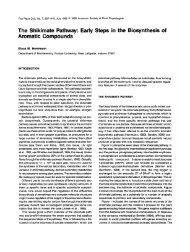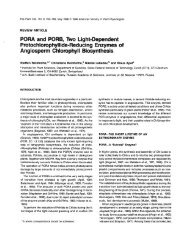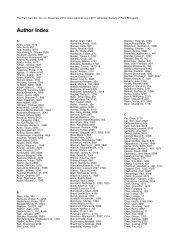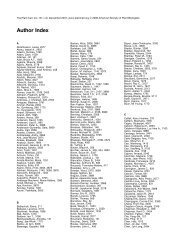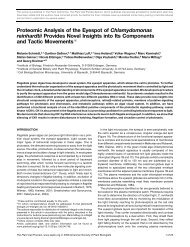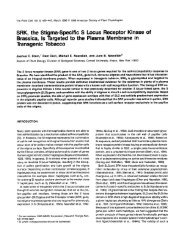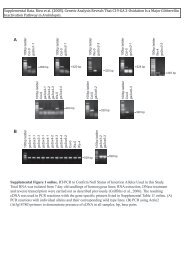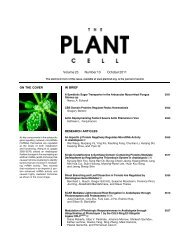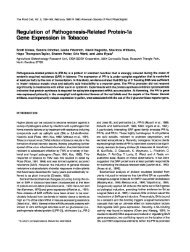The Angiosperm Gibberellin-GID1-DELLA Growth ... - The Plant Cell
The Angiosperm Gibberellin-GID1-DELLA Growth ... - The Plant Cell
The Angiosperm Gibberellin-GID1-DELLA Growth ... - The Plant Cell
You also want an ePaper? Increase the reach of your titles
YUMPU automatically turns print PDFs into web optimized ePapers that Google loves.
6 of 12 <strong>The</strong> <strong>Plant</strong> <strong>Cell</strong><br />
light-mediated hypocotyl growth regulation (e.g., Peng and<br />
Harberd, 1997), but it is only recently that the <strong>DELLA</strong>s have been<br />
shown to contribute to this process. For example, <strong>DELLA</strong>-deficient<br />
Arabidopsis seedling hypocotyl growth is partially insensitive to<br />
light-mediated growth inhibition (Achard et al., 2007a), and <strong>DELLA</strong><br />
deficiency also compromises the shade avoidance response<br />
(whereby plants sense and respond to competing neighbors;<br />
Djakovic-Petrovic et al., 2007). Thus, <strong>DELLA</strong>-mediated growth<br />
inhibition is a component of light-mediated growth inhibition.<br />
<strong>The</strong> light signals that elicit hypocotyl growth regulation are first<br />
perceived by photoreceptors and subsequently communicated<br />
to signal-transducing transcription factors, such as PHYTO-<br />
CHROME INTERACTING FACTOR3 (PIF3) and PIF4. Recent<br />
studies identified a physical interaction between a conserved<br />
Leu-heptad repeat in the <strong>DELLA</strong>s and the DNA recognition<br />
domain of the PIF factors (de Lucas et al., 2008; Feng et al.,<br />
2008). This interaction inhibits the binding of PIF4 to gene<br />
promoter target recognition sequences (de Lucas et al., 2008),<br />
suggesting that <strong>DELLA</strong>s restrain growth by sequestering PIFs<br />
into inactive protein complexes, thus inhibiting their ability to<br />
promote growth via gene transcriptional activation. <strong>The</strong>se observations<br />
provide a possible general framework for understanding<br />
how <strong>DELLA</strong>s inhibit plant growth. According to this<br />
framework, <strong>DELLA</strong>s inhibit growth by interfering with the activity<br />
of growth-promoting transcription factors.<br />
ALTERNATIVE (NON-GA) ROUTES TO <strong>DELLA</strong>-DEPENDENT<br />
GROWTH CONTROL<br />
<strong>The</strong> above described advances provide a molecular framework<br />
for understanding how GA quantitatively regulates plant growth.<br />
However, it is becoming clear that there are additional, GAindependent<br />
factors that can modulate the growth inhibitory<br />
function of the <strong>DELLA</strong>s. One such factor is the putative<br />
O-GlcNAc transferase encoded by SPY (reviewed in Richards<br />
et al., 2001). Loss-of-function spy alleles partially suppress the<br />
dwarf phenotypes conferred by ga1-3, gai, and rga-D17 (Peng<br />
et al., 1997, 1999b; Silverstone et al., 1997, 2007). O-GlcNAc<br />
transferases typically catalyze O-GlcNAc modification of target<br />
Ser residues in regulatory proteins. A reduction in SPY activity<br />
(e.g., as conferred by spy alleles) causes an increase in <strong>DELLA</strong><br />
protein abundance (as detected antigenically or via GFP-<strong>DELLA</strong><br />
fusion), rather than the reduction that might a priori have been<br />
expected for a mutation that causes a reduction in <strong>DELLA</strong>mediated<br />
growth inhibition (Shimada et al., 2006; Silverstone<br />
et al., 2007). One plausible explanation for these observations (as<br />
yet unverified) is that O-GlcNAc modification of <strong>DELLA</strong>s activates<br />
(or enhances) the growth inhibition function of <strong>DELLA</strong>s.<br />
Modulation of O-GlcNAc transferase activity via environmental<br />
or developmental variables thus provides a potential non-GA<br />
route for growth control via modulation of <strong>DELLA</strong> activity.<br />
THE GA-<strong>GID1</strong>-<strong>DELLA</strong> PLANT GROWTH<br />
REGULATORY MECHANISM<br />
<strong>The</strong> advances in understanding outlined in the preceding paragraphs<br />
can be summarized as follows (Figure 4): (1) <strong>DELLA</strong>s are<br />
growth inhibitors that act (at least in part) by interfering with the<br />
activity of growth-promoting transcription factors. In addition,<br />
the growth inhibitory properties of <strong>DELLA</strong>s may be enhanced by<br />
O-GlcNAc modification due to SPY. (2) GA binds within the GA<br />
binding pocket of the <strong>GID1</strong> GA receptor, causing the folding of a<br />
lid structure to which the N-terminal region of the <strong>DELLA</strong>s binds.<br />
(3) <strong>The</strong> GA-<strong>GID1</strong>-<strong>DELLA</strong> interaction reduces the growthrepressing<br />
effect of <strong>DELLA</strong>s, perhaps by reducing their capacity<br />
for interacting with growth-promoting transcription factors. (4) <strong>The</strong><br />
GA-<strong>GID1</strong>-<strong>DELLA</strong> interaction also stimulates the binding of <strong>DELLA</strong><br />
to the SCF SLY1/GID2 E3 ubiquitin ligase. (5) Polyubiquitination of<br />
<strong>DELLA</strong> by SCF SLY1/GID2 targets <strong>DELLA</strong> for destruction by the<br />
proteasome, thus finally removing the agent of <strong>DELLA</strong>-mediated<br />
growth inhibition (Figure 4).<br />
<strong>The</strong> GA-<strong>GID1</strong>-<strong>DELLA</strong> growth regulatory mechanism thus summarized<br />
operates in angiosperms and appears to be a relatively<br />
recent innovation in plant evolution, having arisen sometime<br />
between the divergences of the bryophytes and the lycophytes<br />
from the land plant lineage (Hirano et al., 2007; Yasumura et al.,<br />
2007). <strong>The</strong> most prominent function of the angiosperm GA-<strong>GID1</strong>-<br />
<strong>DELLA</strong> mechanism is regulation of the growth of organs following<br />
their definition in shoot and root apical meristems. For example,<br />
the Arabidopsis ga1-3 mutant has both a dwarfed shoot<br />
(Richards et al., 2001) and a short root (Fu and Harberd, 2003),<br />
in part because GA regulates postmeristematic growth of these<br />
organs. In fact, the GA-<strong>GID1</strong>-<strong>DELLA</strong> mechanism plays a major<br />
role in the regulation of organ extension growth of shoot and root<br />
and does so via interaction with the auxin signaling pathway:<br />
auxin regulates growth (at least in part) by the modulation of both<br />
GA biosynthesis and GA responsiveness (Ross et al., 2000; Fu<br />
and Harberd, 2003). Recent evidence indicates that GA-<strong>GID1</strong>-<br />
<strong>DELLA</strong> regulation of root extension growth is not generally<br />
distributed throughout root cell layers, but operates primarily in<br />
the endodermis (Ubeda-Tomás et al., 2008).<br />
In addition to its major role in modulating extension growth of<br />
plant organs subsequent to their definition in apical meristems,<br />
the GA-<strong>GID1</strong>-<strong>DELLA</strong> mechanism also determines some aspects<br />
of developmental patterning. For example, maintenance of<br />
pluripotency in the cells of the vegetative shoot apical meristem<br />
(the group of cells from which arise the aerial parts of angiosperms)<br />
is in part dependent on dampening of GA-<strong>GID1</strong>-<strong>DELLA</strong><br />
signaling mediated by KNOX transcription factors (Hay et al.,<br />
2002; Jasinski et al., 2005). Conversely, growing (postmeristematic)<br />
cells characteristically have activated GA signaling.<br />
THE GA-<strong>GID1</strong>-<strong>DELLA</strong> MECHANISM ENABLES A FLEXIBLE<br />
GROWTH REGULATION RESPONSE TO<br />
ENVIRONMENTAL VARIABILITY<br />
Possible reasons why angiosperms might have evolved the GA-<br />
<strong>GID1</strong>-<strong>DELLA</strong> mechanism of growth regulation become clear<br />
when one considers the plant life strategy. <strong>Plant</strong>s are sessile<br />
organisms that need to be able to respond appropriately and in<br />
situ to the biotic and abiotic environmental challenges with which<br />
they are faced. <strong>The</strong>re is a particular need to regulate growth in<br />
response to environmental variability, in part because growth is<br />
energetically demanding and in part because growth-driven




